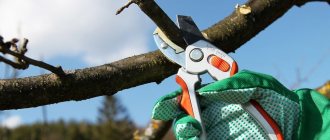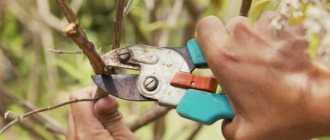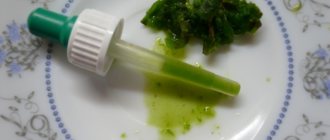Category: Growing and care Reading time: 9 min · Views: 929
Lemon fruiting trees and the small house tree are not different species. The tree is the same, just as the fruits on them are the same. It's all about care. Pruning a lemon prevents it from flying up to the ceiling and “eating” part of the living space in an apartment or house. After proper pruning, the result of which is a bonsai-style tree, it begins to bear fruit, delighting with full-fledged fragrant lemons.
Is it necessary to trim indoor lemons?
Indoor lemon trees must be pruned. Without this procedure, it will not bear fruit and will begin to hurt.
Main purposes of pruning:
- Increasing the attractiveness of a houseplant. Without pruning, the lemon either grows upward with virtually no branches, or turns into a spreading bush with weak shoots. In both cases, the plant looks untidy. With the help of pruning, it will be possible to form a beautiful crown of any shape, increasing the aesthetics of the lemon.
- Stimulation of fruiting. Without timely pinching and removing unnecessary branches, the lemon will spend energy on developing existing shoots without throwing out new ones. In this case, branches of the 4th–6th order (the fruits are formed on them) may not appear at all. A tree with a thickened crown spends a lot of energy on green mass, produces small and tasteless fruits, or even drops its ovaries.
- Prevention of diseases and pests. When thickening in the crown, air circulation is disrupted. Such conditions are optimal for the development of fungal infections. Fungi and harmful insects often settle in damaged and weak shoots, which must be removed.
- Rejuvenation . Pruning extends the life and fruiting of an old tree.
- Improving the taste of fruits. Pruning lemons at home is useful for fruiting. It improves the quality of fruits and increases their size. In a shaded crown, the fruits are small and sour. If you shape the green part so that the ovaries receive enough sunlight, the lemons will accumulate more sugar and be larger and juicier.
When can you prune a homemade lemon?
There is no consensus among experts about when it is necessary and best to prune a lemon at home. Some recommend pruning lemon trees in early spring. There is also an opinion that if you prune indoor lemons in autumn or winter, this will ensure greater yield. And some people believe that lemon trees can be pruned all year round.
Most often, formative pruning of lemons is carried out in early spring.
Its goal is to give the tree crown the desired shape and ensure branching of shoots and growth of fruit branches. This pruning is not carried out every year, but when necessary. You cannot prune the lemon too much or too often, as this depletes the tree and can even lead to its death.
Old trees are also pruned in early spring.
This is a severe pruning in which old branches are removed so that the tree grows as many young branches as possible. Sanitary pruning is carried out in the fall after all the fruits have been removed from the tree.
At the same time, all dry and damaged branches are removed. Weak and “fatty” shoots are also removed. Fattening shoots or tops can be cut out completely or shortened by ¾, since in the future such a shoot may grow into a fruit branch.
Timing of pruning
Citrus plants are pruned once a year . The first time the procedure is carried out already in the first year of the plant’s life, after the trunk reaches 20 cm in height.
Most gardeners believe that the best time to prune lemons is spring , the first half of March. Usually the procedure is carried out before flowering, but at home in a pot the lemon can bloom by this time. During spring work, the plant adapts faster, tolerates stress more easily, and produces new shoots faster.
Some gardeners prefer to prune in winter , after harvesting the fruits. This usually happens in February, before the start of sap flow. If the tree is dormant (not bearing fruit, standing in a cool room), the procedure is not recommended.
Attention! There is an opinion that lemon can be formed all year round. However, experienced gardeners do not recommend carrying out the procedure in the summer. They believe that the best period is from February to March.
Autumn pruning is also acceptable . In this case, work is carried out from late October to November. Most lovers of exotic plants in the fall prefer not to form, but to carry out sanitary removal of weak and damaged shoots.
When is unscheduled pruning necessary?
Citrus trees are pruned once a year. Thinning the crown more frequently will harm the plant.
The younger the tree, the greater the risk of its death due to too frequent pinching.
There are cases in which pruning procedures more than once a year are justified . Among them:
- Defeat by diseases. To save the plant, you will have to act quickly. If possible, remove infected shoots to reduce the risk of infection of healthy branches.
- Severe pest infestation. Remove parts completely eaten away by insects.
- Yellowing of leaves, loss of turgor. Such signs indicate a violation of the rules of care or plant disease. Often the only way to save a citrus tree is to remove the dead branches and replant the lemon.
Pruning rules
Pruning lemons chaotically or just for the sake of appearance can cause harm rather than benefit. Therefore, when taking on such a responsible task, you need to follow some rules developed by generations of people cultivating the cultivation of lemons.
- Excess pruning is done when the lemon tree is in hibernation. More precisely, it is difficult to call such a state “hibernation” in the full sense of the word: the root system absorbs irrigation water, the leaves do not fall off. But many life processes are inhibited or, as it were, postponed for the future. This is a period from approximately October to the end of March. The fact that at home the plant is in the same temperature regime does not mean anything: it perfectly senses the change of seasons, at least by the length of the day (the naturalness of the light) and the spectral composition of the sun's rays. This mechanism is millions of years old, so you can’t fool the tree.
- Before pruning, in an adult already bearing plant, the entire harvest to the last lemon (even if they have not had time to ripen) must be removed.
- The lowest shoots are shortened by 25 cm. The level above is 10. Those located above the second level are shortened by no more than 5 cm.
The procedure is simple, but you must ensure that the instrument (secateurs) and the areas that will be cut are disinfected in a timely manner. This can be done with a solution of 70% alcohol or even purified turpentine.
Don’t be too lazy to measure the length of the branches to be cut from the trunk using a ruler/tape: if you’re off by a couple of extra centimeters, this will give the tree the wrong direction of growth. And it will be possible to correct the mistake only next season.
Formation
Forming a lemon crown is an important stage of care. Not only the appearance of the plant, but also its fruiting depends on the correctness of the procedure .
Features of citrus branching
To properly form a lemon, it is important to understand the peculiarities of its branching.
This will help you understand which shoots to remove and which to leave :
- In the first year, only one shoot will grow; it is called a trunk or trunk. This is a zero-order shoot on which skeletal branches are formed.
- Branches are formed on the trunk - shoots of the first order. This occurs after the plant reaches one year of age. Leave 4-5 such branches.
- On shoots of the first order, branches of the second order are formed. Growths of the third form on them. Next come shoots of the fourth order, on them - the fifth, etc.
- Fruits are formed starting from shoots of the fourth order.
It is believed that branches of a new order grow every year .
Basic Rules
Lemon is formed in compliance with a number of rules:
- It is important to start pruning from zero shoots. The procedure will stimulate the formation of new branches.
- It is important to ensure that buds sprout on several shoots at once. If some of the shoots do not send out new shoots, the extra branches will have to be removed.
- The cut areas are covered with garden varnish. It prevents the plant from becoming infected with diseases and pests.
- Forming a flat crown is better for citrus growing in a pot.
- Branches directed inside the crown are removed or bent outward. It is recommended to direct them to the windowsill. It is best to leave branches pointing outwards, to the sides and upwards.
- When the crown reaches the size of the window socket, the growing points are pinched. Otherwise, the plant will not have enough light.
- The first pruning is carried out only after the height of the zero shoot reaches 20 cm.
- Excess shoots are removed completely, leaving no stumps. They are pinched off as close to the trunk as possible.
- The necessary branches are pinched to the optimal length (usually after the formation of 5–7 leaves). The procedure stops the growth of branches at a suitable length.
Step-by-step instruction
Even beginning citrus growers can handle the formation.
The main thing is to follow the step-by-step instructions :
- The zero shoot is pinched when its height reaches 15–20 cm. After this, the growth point is pinched off. There should be 2–4 live buds left on the trunk.
- Shoots will grow from the buds on the trunk. They are bent in different directions. Pinching is carried out after the length of the branches reaches 20–30 cm.
- Second-order shoots are oriented in different directions and pinched at a height of 20–25 cm. Branches directed into the crown are completely removed. If there are few shoots, they are straightened outwards.
- Branches of the third and fourth order are pruned according to the same principle. Shoots of the new order should be 5 cm shorter than the previous ones.
- After branches of the fourth order, formation is stopped. Only maintenance pruning is carried out.
Formation by bending branches
This method allows you to get side shoots without resorting to pruning. But it will take much longer to form the crown. The procedure is carried out in early spring.
Having determined for yourself the height of the stem (from 15–20 to 30–40 cm), when it reaches approximately twice the size, the top of the lemon is carefully bent so as not to break the trunk. The stamp should maintain a vertical position, everything else should be as close to horizontal as possible. In this position, the trunk must be fixed by tying a thin rope to it approximately in the middle.
The natural direction of tree growth is upward. Therefore, the lemon will try to restore the vertical . A new shoot will emerge from the bend point. It will also need to be bent in the direction opposite to the top and fixed. They do this twice more, getting 4 first-order shoots in 2–3 years.
lemon pinching
Pinching differs from pruning in that the branches are not completely removed, but rather the growth point is destroyed , due to which the shoot lengthens. It is cut from thin branches with scissors, and from thick branches with pruning shears.
Pruning involves shortening the shoot by 1/3 of its length or more . This stimulates the growth of lateral branches. Pinching implies a slight reduction in green mass.
Important! Before pinching, the instrument is sharpened and disinfected with alcohol or a dark pink solution of potassium permanganate.
How to pinch a lemon correctly? Using scissors or pruning shears, cut 2-3 cm from the top of the shoot along with the growth point. Usually the soft part with 1-2 leaves is removed. The cut site is treated with garden varnish.
How to form a crown by pinching
You can shape the crown of a lemon not only by pruning, but also by pinching it. You need to pinch the shoot when it has reached the desired length, but not later. Therefore, you need to gradually form the lemon crown by pinching throughout the year.
The first pruning is also replaced by pinching when the trunk of a young tree reaches a height of 20-25 cm.
After this, the tip of the shoot, along with the upper leaves, is pinched. Further, when level 1 shoots appear on the trunk, they are also pinched, and precisely when their length becomes 1-2 cm longer than the generally accepted norm, namely, a length of 25 cm.
Then, gradually, as the shoots grow, they need to be pinched. This is how the crown of a lemon tree is formed without pruning. This is better for the tree, since pinching occurs gradually, 1-2 shoots at a time, so damage to the plant is insignificant.
Pruning and fruiting
You should not expect the tree to bloom immediately after pruning. The crown is already well branched, but there are no fruiting branches, the tree is stressed and is not ready to flower.
The first flowering and fruiting are possible only after the formation of branches of the 4th order . After their formation, the tree usually does not bloom, so the fruits appear in the 5th year of life.
With a large number of flowers and ovaries, citrus fruits are small and have low taste. Often in this case, the tree drops all the fruits, and if the fruit bears too much fruit, it does not produce them at all the next year.
No more than 4 of the largest and strongest flowers are left on one shoot . The remaining ovaries and flowers are plucked off. First of all, this is done with small and deformed specimens. Branches with a lot of small flowers can be cut out completely. This is also done with shoots on which too many weak ovaries have formed.
In the first year, most of the ovaries are removed from the tree, leaving only 2-3 fruits . The next year their number is increased by a couple more fruits. Then proceed according to the scheme described above.
If these conditions are met, the citrus fruits will turn out large and tasty, and the tree will not drop them . The lemon will have enough strength to develop a moderate number of ovaries.
When to prune
There is a statement that it is necessary to prune a young lemon that was grown from a shortened cutting or seedling before the start of the active stage of the growing season at the age of one year. This is usually done in February. In this case, the home tree should reach a height of 20 cm.
At the same time, there is a slightly different approach to lemon pruning. In this situation, it is carried out in the spring, most often in March, and always before the start of the first growth. Typically, in the spring, lemon pruning is carried out during the flowering and budding period.
You can also find information that homemade lemons are pruned in winter. In this case, pruning is carried out after all the fruits have been removed. This pruning can also be done in the fall. At the same time, autumn-winter pruning of indoor lemon can replace spring pruning. This method will help increase the fruitfulness of homemade lemon.
It is believed that the best time to prune a lemon tree is spring.
It should be remembered that indoor young lemons should be trimmed only when necessary, since frequent and unnecessary pruning can only weaken them.
If you have an old homemade lemon tree, you can prune it for rejuvenation. In this case, weakened branches are cut to the maximum available distance in order to stimulate the growth of new young shoots.
With proper pruning, as well as timely and high-quality care, the lemon tree will bear fruit for a long time, and its life expectancy will noticeably increase.
In the absence of timely and necessary pruning, the lemon will grow with one trunk with no side branches, or as an ordinary dense bush.
Anti-aging pruning
Anti-aging pruning is used for old trees that produce minimal growth of young, poorly fruiting shoots . In this case, most of the branches are cut out. As a result, the tree begins to actively throw out new shoots.
The first few years it may not bear fruit at all, then fruiting will resume. The lifespan of the lemon tree will increase.
Anti-aging pruning is aimed at working with branches from the 3rd order and above . Skeletal shoots of the 2nd and 3rd order are not touched. Only dried skeletal branches are cut out.
Branches from the 5th order are cut out completely . They are removed right down to the base of the trunk, leaving no stumps. The cut areas are sanded with sandpaper and covered with garden varnish.
All dry, weak and old branches of the 4th order and below are removed . They are also cut off at the base, covering the cut areas. Remove branches growing inside the crown.
Attention! After rejuvenating pruning, the tree looks bald. However, new shoots grow quickly and the crown is restored.
After the procedure, it is important to apply fertilizers to stimulate the growth of green mass . It is better to use complex products with a high nitrogen content.
Tips for Beginners
For those wishing to grow a lemon bush at home, professionals give the following pruning recommendations:
- until the crown is formed, all flowers are removed;
- if only one shoot is actively formed, it is completely removed;
- cut out “tops” - branches that stretch upward very quickly and are not capable of flowering;
- For annual growth, anti-aging pruning is carried out;
- If possible, pruning is replaced by pinching;
- at the stage of crown formation, a flat shape is preferred;
- short pruning stimulates the growth of new shoots, and long pruning stimulates fruit set.
Timely pruning without excessive zeal will help to grow a neat indoor tree. Proper care contributes to the annual flowering and ripening of several lemons for the table.
Sanitary pruning
When growing lemons, sanitary pruning is mandatory. It helps to avoid the plant becoming infected with diseases and attacked by pests . First, carefully inspect the tree for signs of infection.
Remove all damaged, broken branches . Shoots with cracks in the bark are also cut off. If there are signs of damage on the branches, treatment is carried out. Severely affected parts are removed.
After sanitary pruning, preventive spraying is carried out with a solution prepared from 3 liters of water and 1 tsp. copper sulfate.
Pinching and removing excess blooms
Lemon productivity depends on flowering. The more magnificent it is, the more energy of the plant is wasted and the fewer ovaries there will be. At the flowering stage, small buds that are damaged and irregular in shape are pinched. After opening, remove with a short stigma or without a pistil. Additionally, branches with very few or no buds are pruned.
The age rule applies to the number of fruits sufficient for one tree. At 3 years, only 2-3 lemons are left to ripen. At 4-5 years the plant is able to increase the yield to 7 fruits, and after 7 years a good harvest consists of 10 fruits. If all excess is removed in time, the tree will produce a good harvest for many years.
Preparation of cuttings for propagation
Lemon cuttings do not need to be specially cut. Planting and grafting material is also prepared during formation. To do this, wait until the branches that will be cut reach such a length that there are 3-4 buds on a separate part.
Excess shoots and branches directed inward are used as planting material . Weak, dry and diseased shoots are not suitable.
Important! To prepare high-quality vegetative material, the plant is watered before pruning.
Sometimes lemon trees produce little growth. In this case, there will not be enough cuttings for planting. To stimulate the formation of branches, all new fruiting branches are pruned . This stimulates the rapid growth of green mass, but there will be no fruit this year.
Crown formation
It is best to shape your lemon tree into a flat shape. This lemon crown is considered the best for home growing.
In order to form such a crown, you need to direct shoots of all levels to the windowsill at a certain time, and if necessary, cut them off and break them off. Then, when the dimensions of the crown of the tree and the window opening become the same, hard pinching is carried out, and you can even trim it. In this case, you can form a so-called “living curtain”. With such a crown, the lemon will feel great and produce a good harvest.
It is important to monitor the formation of “fatty shoots”; if they are noticed, they must be removed immediately.
The formation of a lemon crown is similar in basic principles to the formation of the crown of an ordinary fruit tree.
There is another method of forming a crown, which involves cutting all the branches to a certain length. But with this method, there is a risk that your lemon will not bear fruit this season.
It is best to perform corrective pruning, in which new branches are only slightly shortened. A few weeks after this event, new growth sites will form at the site of the cuttings, and soon new young branches will appear. It is important to do everything as carefully as possible, trying not to damage the tissue of the tree trunk, because this can disrupt the growth of the lemon.
Crown formation must be completed before fruiting begins. But we must remember that removing flowers and ovaries from a branch promotes its growth. In this way you can regulate the yield; rationing the yield is very important so as not to deplete your plant by excessive flowering.
Excessive blooming on lemon should be removed, otherwise it will weaken the plant.
Lemons, compared to other fruit trees, have very lush flowering. And despite the fact that a large number of flowers looks very beautiful and pleases the eye, abundant flowering can greatly deplete your tree. The result of such depletion may be a small number of fruits or their low quality. To avoid all these unpleasant consequences, you need to prune during the flowering period of the tree. In its process, all weak and poorly flowering branches are removed. This procedure will help you get a good harvest of lemons.
Possible problems and tips
In order for pruning to bring more benefits and be successful, it is important to consider some nuances :
- Removing excess flowers. Excessive flowering affects not only the quality and quantity of fruits, but also the development of the tree as a whole. If you do not pinch off the excess inflorescences in time, the citrus will dry out within several years.
- Feeding. A week before pruning or a week after, the tree is fertilized with nitrogen. This will help the plant tolerate stress more easily and stimulate the growth of green mass.
- Annual pruning work. If you skip them, fruiting will come later and the tree will develop incorrectly.
- Crown trimming. To give indoor citrus a more aesthetic appearance, use scissors to form a green mass, cutting off only the tops of the shoots. The procedure can be carried out all year round.
- The plant is not allowed to flower until the crown is formed, otherwise the yield will be low, growth will slow down, and the risk of plant death will increase.
- When forming, it is important to be careful and follow the instructions. It will be difficult to correct the mistakes made.
- Excessive pruning stimulates the formation of new strong shoots. Pinching the tops awakens the fruit buds.
- Branches of the 5th order and higher are pinched after 5–7 leaves. This simulates flowering and ovary formation.
Sometimes when forming a crown, a citrus grower encounters difficulties:
- In the place where 3 or 4 shoots appear, only 1 branch is formed. To correct the situation, the branch is broken off. If the next growth again does not produce the required number of shoots, the procedure is repeated.
- Tops form on the lemon - branches that grow vertically and increase in size faster than others. Fruits do not form on such shoots. Experienced gardeners recommend cutting them to the base. Some citrus lovers do not remove the tops, but shorten them to 25 cm.
First pruning of a lemon tree
The first lemon pruning is carried out in February during 1 year of the plant’s life. At this time, the young plant does not yet have side shoots, but only a straight trunk. The first pruning of a lemon forms a trunk and ensures the appearance of several side shoots.
To do this, you need to examine the trunk of a young tree and find dormant buds on it , from which the branches of the plant will appear. It is best if there are 3 or 4 buds and they are located in a circle at the same height.
Then an incision is made 1-1.5 cm above them and the upper part of the trunk is removed. The lower part remains for the trunk and future crown. Cut the trunk 20-25 cm above the soil level. The work is carried out with sharp garden pruners. After the operation, the sections are filled with garden varnish.
Care after pruning
After the procedure, be sure to coat the cut areas . Use garden pitch or other suitable remedy. It is not necessary to cover the cut areas of thin branches.
After pruning, the lemon is placed in a shaded place for 2 weeks , protected from direct sunlight. The room temperature should not exceed +20°C. It is important to control humidity between 65-80%. If these indicators are exceeded, the risks of rotting increase.
After the procedure, fertilizing is applied . Use complex fertilizers with nitrogen.
Schemes and technologies of the procedure
Pruning patterns and technologies vary depending on what goal ultimately needs to be achieved. Sooner or later you will need each of them, so read these points carefully.
For abundant flowering
The lemon tree spends a lot of effort and energy on flowering. So if there are shoots with a small number of buds, old, weak or diseased, then flowering will not be effective. To stimulate the growth of others, healthy and strong, these will have to be removed. Don’t feel sorry for them; pity will only make the situation worse. You won't get anything useful from such branches anyway.
.
The main advice in this regard is accuracy. Firstly, this way the cuts will heal faster and the tree will not have time to react. Secondly, other shoots will remain intact.
Author's note
Natalia Papanova
Blog author
If the plant begins to bloom in winter, remove the flowers. Leave a couple of pieces for scent.
Lemon flowers exude a very pleasant and delicate aroma.
For fruiting
The fruits appear for the first time only after the “skeleton” of the lemon tree is formed. My fourth-order branches have become stronger.
To make the harvest not only voluminous, but also large, some branches are removed. These include the following:
- shoots with a small number of flowers;
- branches without flowering (we definitely don’t need those);
- weak branches that may not support the weight of the formed fruits.
Is your lemon bearing fruit?
Not really
Rejuvenation of citrus trees
Lemon trees live a long time if properly cared for. However, to keep it fresh and neat, prune to rejuvenate the crown. It is not carried out often: once every 4-5 years. Or maybe even less often (if you forget).
During the procedure, branches up to levels 4 and 5 are removed. Thanks to this, new branches will begin to grow, which until this moment are in the “dormant” buds. Afterwards, the lemon is transplanted into new soil and a pot, while removing 30% of the old roots (don’t worry, everything will be replenished and young ones will form). Well, at the final stage, of course, feed the tree with the available fertilizer.
Author's note
Natalia Papanova
Blog author
Carry out superficial anti-aging pruning regularly. It involves removing dried and dry branches.
For propagation by cuttings
The advantage of an adult lemon is that it produces planting material (cuttings), and after they take root, a couple more citrus specimens. For this purpose, healthy and strong shoots are cut off from the main branch at an angle. They must meet the following characteristics:
- length – 10-12 cm;
- leaves are present;
- the bark has no damage or dry areas;
- no pests.
Next, pass the cuttings into a special means to stimulate root growth. I use: “Kornevin”, “Zircon” or “Root Super”.
You can also propagate the tree in other ways. For example, I do lemon grafting at home for these purposes. So I have already received 2 healthy specimens of citrus crop.
Removing flowers
The weight and size of the resulting fruit can be controlled by removing flowers. Why deletion, you ask. Everything is simple here: abundant flowering is not a sign of obtaining a large amount of harvest. On the contrary, if there are a lot of flowers, then the tree will not have enough strength and will drop them. To prevent this from happening, unnecessary ones are removed.
The number of buds that are left depends on the age of the plant:
- three years - cut off half of the total volume;
- the tree is 4-5 years old - leave ¾ of the flowers, and after only 7 fruits for formation;
- reached 6 years or more - leave it and don’t worry about it.
And don't cut everything off. Remove weak flowers or empty flowers. Leave large, developed ones.
Lemon cuttings take root better than seeds
To form the crown
For lemons I form a flat crown shape. It's easier to grow this way. You can choose another option for yourself. The main thing to remember is that you need to trim. And this is the tip of each branch. Once it has grown to the desired size, trim it. So gradually and carefully you will form the “cap” of the plant as you wish.
Sanitary
This pruning is carried out annually. Its purpose is to remove damaged branches (dry, diseased or with pests). As a result, the tree takes on a healthy appearance, and infection or parasites do not spread to the remaining parts of the plant. Shorten until you reach the tissue without damage.
And to be honest, lemons rarely get sick (at least for me). But it’s better to prepare for everything in advance. Therefore, before planting, I looked at what could be wrong with homemade lemons and how to treat them.
To learn how to restore a lemon if it has dried out, watch the following video at the link:
Carrying out subsequent pruning
The first stage of crown formation is the most important; it determines whether the tree will bear fruit. In the second year of life, the seedling develops lateral branches (they are called branches of the first order), there should be 3-4 such shoots, which is why during the first pruning it was necessary to leave 3-4 buds. To form shoots of the third order, pruning is also carried out. Next, the tree itself will form a crown, and will begin to bear fruit after the appearance of fourth-order branches.
It is common to use two removal methods:
- partial – shortening of the “fattening” branches by 25 cm;
- complete - this is how dead or old tree branches that can cause disease are most often destroyed.
Removal of shoots occurs when they interfere with each other's development. In this case, the strongest shoot is left, and the weak one is cut off.
Advice
If the shoot is strong, but grows vertically, it should be removed, leaving a weaker one, but growing horizontally. At the top of the plant, the shoot growing upward is cut off first.
Fruiting
It is worth noting that it is better not to allow fruiting until the formation of all skeletal branches of the lemon crown is completed .
This is explained by the fact that the branches develop very poorly under the heavy weight of the fruit. In most cases, when buds form prematurely, they are simply torn off.
And here is a video about how to form a crown, how to prune a lemon correctly so that it bears fruit.
It will be useful for everyone who grows lemons at home to learn about the benefits and harms of its fruits, the secrets of caring for a tree in autumn and winter, the necessary fertilizing, the rules of planting, replanting and ideal soil, as well as problems with foliage and how to solve them. solutions.
Why is pruning needed?
There are several reasons why you should prune your plant.
- It helps make the crown even and neat.
- The procedure helps rejuvenate the old tree.
- If the plant is not pruned, it will grow tall and not bear fruit.
- Pruning reduces the risk of tree diseases developing.
- A properly formed crown will increase the life of the plant and the duration of fruiting.
The crown should be given an even shape even if there is no goal of producing fruit, otherwise the tree will look untidy.
Let me sum it up
- Do not prune during flowering and fruiting. The lemon tree may not withstand the load and even die.
- After pruning, feed the plants with organic or inorganic fertilizer to reduce stress.
- Before the procedure, remove the entire harvest from the tree, no matter at what stage of maturity it is carried out.
- Do not leave fatty shoots - these are arrogant comrades who do not give anything, but, on the contrary, only take away the strength of the plant.
Sometimes it seems that pruning a lemon at home is a complicated process. But you shouldn’t be afraid if you have studied the rules and features of the procedure. As they say: “Fear has big eyes.” So don’t be afraid and feel free to start forming the crown of the tree.
Trimming scheme
The tree trimming pattern looks like this:
- In the first year, only the trunk is pruned; this will promote the formation of side shoots. If this is not done, the lemon will begin to grow upward and will become an unattractive “stick”. The height of the plant should be 25-30 cm from the ground.
- In the second year, the side branches are pruned. It is necessary to ensure that 3 new shoots begin to actively grow and develop. If only one grows, it should be removed completely to encourage the others to grow. This process is called breaking out.
- Next, third-order branches are pruned.
- The formation of the crown is completed by pruning the branches of the fifth order, after which the tree can be given the opportunity to bear fruit.
The main task is to give the crown a fan-shaped appearance.
Advice
If one of the young shoots grows vertically, you can not cut it, but give it the right direction by carefully wrapping it with wire and fixing it in the required position.











